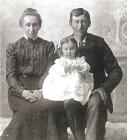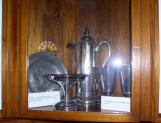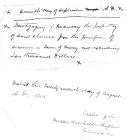28
Picture is of Bethel Meeting House -used as a storage barn.A deep division occurred in the church over a controversy that grew out of leadership decisions concerning the newly built parsonage. A number of members left the church and on March 9, 1839 the Second Church was organized. The meeting house they built was called Bethel Chapel (completed April 3, 1842). It was built on a site only a few yards from the old sanctuary. The pews were "sold" and brought in more than enough to pay the bills. At this time, it was common for a person or family to "purchase" the right to sit in specific seats. These church pews had doors at the aisle end of the seats to further set apart the reserved seating from others who would attend. These pew doors were removed from the aisles in 1880 to establish Bethel as a "free house" - churchgoers were free to sit wherever they desired. Some members took offence to this action and thereafter refused to attend church. Rev. Joseph Crandall became Bethel's first pastor. Nearly fifty years later the First and Second Church congregations reunited. Upon completion of the construction of the currrent church building in 1905, Bethel Chapel was sold. It was used by the Campbell Carriage Factory as a warehouse and was eventually torn down in 1951.
29
Those remaining with the old congregation were distinguished from the newly formed Bethel congregation by being referred to as the "First Church." The First Church opened its new meeting house, Beulah, in January 1844. The new site was chosen (called "Four Corners") providing a central location in the community. In 1889 this building was sold. It was used as a barn until it burned in1924.30
Salem Chapel (Main Street Baptist Church) founded by The 'Second' Church1849
Sackville, New Brunswick, Canada

31
The Second Church built the Salem Chapel in 1848 (opened July 27, 1849) as a mission outreach to the people living in the developing commercial center for the region. The Salem Chapel was the basis for what is now Main Street Baptist located in the town of Sackville.The picture is of the Main Street Baptist Church (circa 1850).
33
Communion set from Bethel Chapel originally purchased during the 1840's."As I see the former silver dishes used at communion service in the cabinet made for them, I am reminded of my mother setting the [communion] table in the old Bethel Chapel. She had done that all my young life. On Saturday morning my father would say to her, "Remember to cook the bread for the Lord's Supper tomorrow." This was not made like everyday bread, as it was less liable to crumble when cut or broken.
Bethel [the sanctuary] was in one room, first Sunday School, a short interval, then the morning service. A slight platform was between the floor and the pulpit. The communion table was on this platform. On this my mother would first spread a fine linen tablecloth. Then place the two plates in the center. On these was the high plate on which was placed the bread. Mother had cut a square of bread about six inches deep almost to the crust. Then she sliced it down not quite to the bottom so it would not fall apart. She made small slits both ways which left cubes of bread standing together. Then [at the appropriate time in the service] the pastor broke off [the loaf] into small pieces on the plates. There on one side was the pitcher of "so called " wine. This was made each summer from blueberries and tightly bottled until needed. Then on the other side were two goblets. Over all of this my mother placed a smaller tablecloth. Then her task was done.
When I think of my mother, it is always in the church at Bethel setting the table for the Lord's Supper."
- An account of communion preparation in the 1880's & 1890's written by Ethel Thompson Berrie (1878-1971), daughter of J. Willard and Alice Thompson. She married and moved from the area in 1903.
34
Even though the Bethel and Beulah congregations were separated by animosity over the dispute, they often engaged the services of the same pastor.Pastors often traveled long distances to carry out their duties. Rev. Thomas Todd who served this pastorate (1861-1873) would usually preach at Bethel or Beulah in the morning, at Salem at 3 p.m. and either Wood Point or Coles Island in the evening. One day it was recorded that he preached at Bethel in the morning, Salem at 3 p.m., married a couple at Beech Hill and preached at Coles Island in the evening while traveling on primitive roads (a 40 kilometer trip) described as "bad and very muddy."
35
There is a notation in the record book of Second Church that Rev. Thomas Todd had been called upon to travel to Shediac (some 50 kilometers away) to conduct a baptismal service on May 14, 1865. This trip would have been taken on very primitve roads stretching through the interior of the province. It would have been a very demanding trip for a busy pastor.In the early 1860's it was reported that on one occasion during a funeral service conducted by the pastor (probably Rev. Todd), he stopped the funeral procession to the church or gravesite, while he went to the waters edge (a river, pond, or lake) to conduct a batismal service. Pastors have always had to be flexible in their approach to carrying out the tasks involved in ministry.
36
Although in 1883 the congregations of the First and Second churches voted to rejoin as one body, the minority who objected to the reunion negotiated the resignation of all officers and both pastors. The reunion was effectively established in April 1885 with the election of new officers and the calling of a new pastor.The Salem church had outgrown the Chapel and erected the Main Street building in 1890. The Chapel building was sold to the Intercolonial Railway. It burned down in 1908. The community of Sackville had been steadily growing and became the business center. Salem negotiated a separation from the rest of the pastorate. On September 22, 1902 the members agreed that Baptists living south of the Odgen Mill Road would be members of Main Street Church (formerly the Salem mission) and Baptists living north of this line should be members of the Middle Sackville Church (name changed on October 6, 1902). Of course individual members were free to go to the church of their own choice.
38
During 1905 the current Middle Sackville church building was erected.These scraps of paper seem to be hand written notes by someone giving instruction to the pastor, Rev. E. L. Steeves, regarding the wording of the church document authorizing a lawyer or banker to draft a mortgage for the proposed new church building. The new building and furnishings cost $8,193. It was built near the site of Bethel Chapel on land purchased in 1903. The house that was acquired on this property has been used as the parsonage (minister's residence) since the church was built.
39
Isaac Cook with his wife Louise and youngest daughter, Mary.1905
Middle Sackville, New Brunswick, Canada



